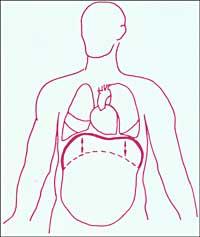Hipo
1986/08/01 Agirre, Jabier - Medikua eta OEEko kidea Iturria: Elhuyar aldizkaria
Do we know exactly what is hiccups? Spasmodic and involuntary contraction of the membrane (called DIAFRAGMA) formed by muscles and left-handed ones that separate the abdomen from the breast cavity.
At that time the abdomen is hard and stiff, inserted inside, and the contraction of the diaphragm momentarily interrupts the breath, producing a very special noise during the expiration.
It occurs when it irritates or stimulates the nervous sense of hiccups (located in the brain bulb) or the frienic nerves that inert the diaphragm. But what is it that causes the blow? The causes are very varied: it usually appears after excessive irritation of the stomach (it can appear by a weight of food or chewing badly). Or because digestion is delayed (cold, effect of the nerves). It is, in general, an event of little entity, which ends immediately.

But in other cases it can be a reflection of other more serious and serious situations. Therefore, if after a few minutes it does not disappear, and of course when attacks and jams occur that can last full days and weeks, the situation can get worse until life is endangered.
In childhood, especially in infants, it can be more persistent; usually it is due to the cooling of the body due to the pressure of intestinal gases or to slight alterations or mixtures of the digestive system, being frequent the worry and anguish of the parents. Fortunately, it is not usually very serious.
What to do to stop hiccups?
The best system is to drink water in small swallows, little by little, without breathing and closing the nose. What physiological explanation does this have? On the one hand, the diaphragm is at rest and with some water and air retention.
If the above measures were not successful, the person will lie face-up, flexing the knees to relax the muscles of the abdominal wall. Subsequently, the ingestion of a rib with fingers by another person, without any effort, would maintain that resting situation, that small effort that involves drinking water little by little, needs our admiration, and so, indirectly, would help to relax the diaphragm.
The maintenance of breathing, often, will cause the disappearance of zotine. There are many ways to make it easier: count without breathing (up to twenty for example), or repeat the same phrase aloud and in haste. During a season you can also circulate with your mouth open, pressing to your breath the muscles that are under your bones, alternatively pushing them inside and out.
If it is a child, a patch or blanket placed on the stomach (just a fabric soaked in hot water and then well drained) can solve the problem. If the child is very small it can be changed posture and a light pressure can be applied to the massage mode on the stomach. In infants, in most cases, it occurs by leaving the baby without drying well or wet. In these cases it is arranged very easily if we cover it in dry and warm fabric.
Keeping the person warm is beneficial in all cases.
Other tricks
The tricks mentioned below are, according to customs and customs, the procedures that have reached our days. Some will get more success than others, but since they will not cause harm, we will quote them in that sense.
- Slight cooling of the ear shackles by means of water or saliva. It is not necessary to lower the temperature very much, it is only necessary to moisten the ears. Suck a bundle of sugar soaked in vinegar or take a nice tablespoon of sweet vinegar of sugar. Another system indicates that you have to swallow a tablespoon of sugar powder without water. Be looking at the sun to cause usine or sneezing. Covered with ears.
- Swallow two or three grains of salt, etc.
We cannot fail to mention the well-known system that proposes to “frighten” or run over the person who is on the floor.
In the hope that with the aforementioned data we have been able to solve a small problem, but often annoying.

Gai honi buruzko eduki gehiago
Elhuyarrek garatutako teknologia



